Site Search
Follow us on


Affiliates
Books About Music
Biographies

-
Francesco Geminiani (1687-1762): Part 1: Life and Works; Part 2: Thematic Catalogue. Enrico Careri. Oxford University Press. 1993. ISBN 0198163002 (hardcover).
-
Although Francesco Geminiani is a relatively well-known composer whose name is frequently cited in studies of baroque music, his biography and works have been relatively little researched. His music was often analyzed without due reference to biographical and historical background, and his multifarious activities as violinist, composer, theorist, and small-scale entrepreneur were never considered in their full interrelationship. This volume represents a first attempt at providing a comprehensive account of a composer who in the first half of the eighteenth century dominated the English musical scene alongside Handel. The book traces Geminiani's life and career from his birth in Lucca in December 1687 to his activities in three centers: London, Paris, and Dublin. After analyzing the critical reception to Geminiani, both contemporary and modern, Careri examines his compositions by genre, illustrating his remarks with thirty-nine music examples, some presented in facsimile. The book also includes a complete thematic catalogue with music incipits, containing details of primary sources, reworkings and transcriptions, and modern editions.
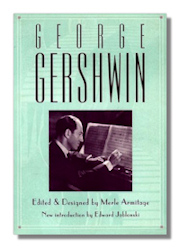
-
George Gershwin. Merle Armitage (Editor), Edward Jablonski. Da Capo Press. 1995. ISBN 0306806150 (paperback).
-
Shortly after George Gershwin's premature death in 1937, Merle Armitage invited Gershwin's friends and associates to contribute memories and tributes for this volume, which was first published in 1938. In these 38 articles, a range of interests are covered, comprising a portrait of a musician who exerted a huge influence on his era. Here Ira Gershwin reminisces about his brother's childhood and career; Paul Whiteman traces the history of "Rhapsody in Blue"; DuBose Hayward and Rouben Mamoulian discuss the genesis of "Porgy and Bess"; J. Rosamond Johnson examines Gershwin's African-American influences; Arnold Schoenberg discusses Gershwin the musical innovator; Harold Arlen attests to Gershwin's kindness to his fellow composers; George Gershwin summarises his approach to modern music; Oscar Hammerstein II, Isamu Noguchi, Rudy Vallee, Jerome Kern, Irving Berlin, and many others contribute recollections, observations and thanks. This volume also includes 16 of Gershwin's own paintings, along with many other artworks and photographs. This book provides insights into Gershwin the man and the composer.
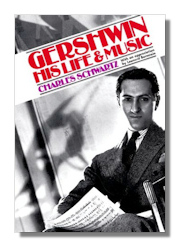
-
Gershwin: His Life and Music. Charles Schwartz. Da Capo Press. 1988. ISBN 0306800969 (paperback).
-
The name George Gershwin is a magical one. It conjures up the Twenties, Broadway glitter, beauty and extravagance. Begin humming a Gershwin tune anywhere from Boston to Bangkok and someone will finish it for you: Rhapsody in Blue, Summertime, Lady Be Good, An American in Paris, to name a few. Called "Mr. Music" by his contemporaries, Gershwin (1898-1937) was a musical genius whose life epitomizes the American success story. The son of Russian-Jewish immigrants, he was raised on the Lower East Side and never finished high school, yet grew up to become rich, famous, and the intimate of celebrities. Although George Gershwin's life was cut short by illness over sixty years ago, he is probably better known today than ever before. And yet too often he is the subject more of popular invention than of truth. In Gershwin: His Life and Music, author Charles Schwartz attempts to redress this imbalance by separating fact from myth. The result is an extraordinarily fascinating and honest account of the man who created such beauty that he became a legend in his own time.
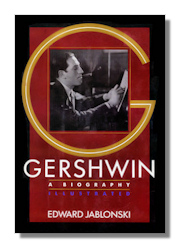
-
Gershwin a Biography. Edward Jablonski. Anchor (formerly Doubleday). 1987. ISBN 0385194315 (paperback).
-
Enriched with excerpts and insights from personal correspondence and interviews – plus lively anecdotes and rare, never-before-published photographs – this fascinating portrait brings us closer to the real persona of George Gershwin than ever before. Included are 81 black-and-white photographs.
-
Gershwin Remembered. Edward Jablonski. Amadeus Press. 1992. ISBN 0931340438 (hardcover).
-
The life and work of Gershwin recalled by friends, colleagues, associates, and pupils, including Koussevitsky, Schoenberg, Richard Rodgers, and his brother Ira.
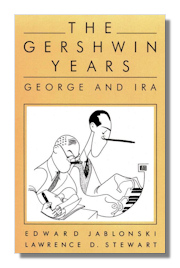
-
The Gershwin Years: George and Ira. Edward Jablonski, et al. Da Capo Press. 1996. ISBN 0306807394 (paperback).
-
Both the definitive biography of the Gershwin brothers and a lavishly illustrated chronicle of the American era their music and lyrics embodied, The Gershwin Years celebrates the musical achievements of George (1898-1937) and Ira (1896-1983) while offering a revealing inside look at their lives. The brothers drew inspiration from its varied faces – black culture from Porgy and Bess, the frantic sophistication of the 1920s for such musical comedies as Funny Face and Girl Crazy, the tumult of American politics for the satirical Of Thee I Sing. From George's Tin Pan Alley days as a song plugger and Ira's first attempts at lyric writing to their conquest of Broadway and Hollywood, from their collaborations and George's solo compositions (Rhapsody in Blue, Concerto in F, and An American in Paris) to George's death from a brain tumor and Ira's later work with Kern, Weill, and Arlen, The Gershwin Years presents an authoritative, visually stunning, and altogether delightful account of the "Wright Brothers" of American music.
-
George Gershwin. Rodney Greenberg. Phaidon Press. 1998. ISBN 0714835048 (paperback).
-
This expert and colorful biography places George Gershwin's (1898-1937) music within the context of his frenetic lifestyle to show how a teenaged song-plugger from Tin Pan Alley became internationally renowned in a career that spanned a mere two decades. It also beings home the realization that Gershwin's tragic death from a brain tumor at age 38 robbed the world of untold musical treasures.
-
The New Grove Russian Masters, I. David Brown, et al. W.W. Norton & Company. 1997. ISBN 0393315851 (paperback).
-
Comprehensive biographical articles taken from the New Grove Dictionary of Music & Musicians. Included are: Mikhail Glinka, Alexander Borodin, Mili Alexeyevich Balakirev, Modest Musorgsky, and Piotr Ilyich Tchaikovsky
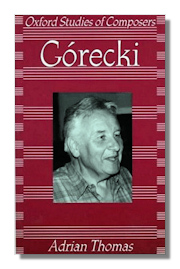
-
Gorecki (Oxford Studies of Composers), Adrian Thomas. Oxford University Press. 1997. ISBN 0198163940 (paperback).
-
This book is the first detailed study of Polish composer Henryk Gorecki, whose Third Symphony, written in 1976 and released on CD in 1992, became a bestseller and brought Goreki international renown. Written by a leading enthusiast of Gorecki's music, this volume ranges from the composer's large orchestral scores (Sconti, Refrain, the Symphonies) and choral works (Beatus Vir, commissioned by and dedicated to Pope John Paul II) to the more modest church songs and folk-song arrangements. Granted numerous interviews and access to unpublished material, the author discusses Gorecki's position as leader of the Polish avant-garde in the late 1950s, and his subsequent discovery of the folk and church music of Old Poland, most notably that of the Podhale region in southern Poland. The book includes a complete list of works since 1955 with details of instrumentation and recordings, and a select bibliography.
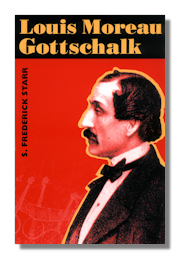
-
Bamboula! The Life and Times of Louis Moreau Gottschalk. S. Frederick Starr. Oxford University Press. 1994/2000. ISBN 0195072375 (hardcover) 0252068769 (paperback).
-
Innovating American composer, virtuoso pianist, and swashbuckling Romantic hero, Louis Moreau Gottschalk produced immensely popular works combining the French, Hispanic, and African influences of his native New Orleans. Many of his syncopated compositions anticipated ragtime by half a century. S. Frederick Starr's biography, originally published as "Bamboula!", is the most extensive chronicle available of Gottschalk's eventful life. Starr examines Gottshalk's music, his frenetic life on the road, his virtuosity as a performer, his effect on his audiences, and the scandals surrounding his romantic dalliances. He also reveals a generous and compassionate man who sponsored a host of young musicians and provided financial support for his many siblings.
Glenn Gould
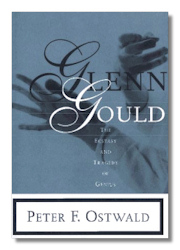
-
Glenn Gould – The Ecstasy and Tragedy of Genius. Peter F. Ostwald. W.W. Norton & Company. 1997. ISBN 0393040771 (hardcover), 0393318478 (paperback).
-
An intimate portrait that captures the brilliant fusion of genius and madness in the tormented life of pianist Glenn Gould. The Canadian pianist Glenn Gould was a musical genius a child prodigy whose rise to world fame was jump-started in 1955 by a sensational recording of Bach's daunting "Goldberg Variations." Gould's infectious enthusiasm, his puerile sense of humor, and his flamboyant ideas reaffirmed the power of music as play. But along with his charm, Gould was tragically disturbed. He consulted scores of doctors, avoided intimacy, and never married. Struggling against a lifelong sadness that always threatened to overwhelm him, Gould neglected his health and died prematurely at age fifty of a massive stroke. Glenn Gould's life raises many questions about the phenomenon of genius. Was Gould's brilliance sponsored by his madness or vice versa? Do men and women of genius sacrifice themselves for a higher ideal while remaining personally unfulfilled? Peter Ostwald, a noted psychiatrist and a musician, lays bare the energy and contradiction that composed Gould's genius. Read the Classical Net Review of this book.
-
Glenn Gould: Selected Letters. Glenn Gould, et al. Oxford University Press. 1995. ISBN 0195411420 (paperback).
-
Since Glenn Gould's death in 1982, the pianist's extraordinary talent has captivated new listerners through the re-release of his most famous recordings. Recently, a stage play and a feature film, "32 Short Films About Glenn Gould," introduced the eccentric artist to a new audience. With the publication of these 184 letters, a wide range of Gould's artistic activities is presented. Whether he is writing to esteemed musicians such as Leonard Bernstein or Leopold Stokowski, or to friends and colleagues in the world of performing and broadcasting, or answering the numerous fans who sent him questions, Gould explores all aspects of the art of making music. In his own words, we hear about his favorite Bach, the choice of tempi for Beethoven's late piano sonatas, the power of Richard Strauss and Arnold Schoenberg, to name only a few of the musical concerns that fill his correspondence. His letters, which concentrate on the creative life, provide a rare glimpse into how the man worked, suggesting, finally why he devoted himself to music with such dedication and single-mindedness. A valuable addition to "Gouldiana," Glenn Gould: Selected Letters will give pleasure to all students of the piano, admirers of Gould, and music-lovers who have ever wondered how a great musician thinks about his art.
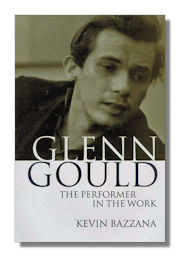
-
Glenn Gould: The Performer in the Work: A Study in Performance Practice. Kevin Bazzana. Oxford University Press. 1998. ISBN 0198166567 (hardcover).
-
A detailed study of the great Canadian pianist, broadcaster, writer, and composer Glenn Gould (1932-82). While looking primarily on his performances, it also situates his work and thought more broadly within relevant musical, cultural, intellectual, and historical contexts. It incorporates most of the existing primary and secondary literature on Gould, as well as many ideas, interpretations, and perspectives that have never before been discussed. It also incorporates ideas from a wide range of literature, both musical and otherwise, and draws from unparalleled access to the Glenn Gould Papers in the National Library of Canada. The book offers a more comprehensive, balanced, and thoroughly researched portrait of Gould as pianist and interpreter than any previous volume in the Gould literature. Following an introduction that summarizes Gould's career and the posthumous interest in him, the book divides into two parts. Part 1, "Premises," focuses on the intellectual and aesthetic ideas that informed his performances, and draws on literature from many fields, including music history and aesthetics, cultural history, the history of performance practice, theatre, literary criticism, and music analysis. Part 2, "Practices," focuses in detail on Gould the pianist, illuminating important features of his style through prose description and critical analysis, and including graphic musical examples, plates, and a supplementary Sony Classical CD of Gould's performances.

-
Glenn Gould: A Life and Variations. Otto Friedrich. Vintage Books. 1990. ISBN 0679732071 (paperback).
-
He was a virtuoso of the piano who inspired an almost religious fervor in his fans, yet he hated performing and left the concert stage forever at the age of 31. He was a tireless advocate of the technology of recording, an artist who looked forward to a time when mere musicians would be rendered obsolete. He was a notorious -- and, some thought, a deliberate -- eccentric, who muffled himself in scarves and gloves, liberally dosed himself with pills, and once sued Steinway & Sons because one of its employees had shaken his hand too roughly. He lived in hermetic solitude and liked to call himself "the last Puritan," but those who watched Glenn Gould play piano saw an eroticism so intense it was almost embarrassing. Drawing on extensive interviews and on archival materials that were previously inaccessible. Otto Friedrich has written a biography of exemplary depth and stylishness. Ranging over Gould's brief but spectacular public career and his prodigious exploits as teacher, author, and lecturer, his public opinions and his intensely private life.
-
The Glenn Gould Reader. Glenn Gould, Tim Page (Editor). Vintage Books. 1990. ISBN 0679731350 (paperback).
-
Whether Gould's subject is Boulez, Stokowski, Streisand, or his own highly individual thoughts on performance and creation of music, the reader will be caught up in his intensity, intelligence, passion and devotion.
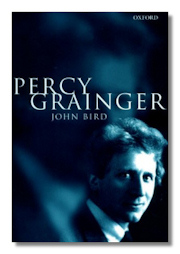
-
Percy Grainger. John Bird. Oxford University Press. 1999. ISBN 0198166524 (hardcover).
-
This extensively revised edition of John Bird's acclaimed biography of Percy Grainger gives the first circumstantial account of the life and works of one of the strangest figures in twentieth-century music. Behind Grainger's highly original compositional achievements, folksong collecting, and glittering career as a virtuoso concert pianist lay a tragic and chaotic personal life, long domination by his mother, unorthodox sexual predilections, an eccentric athleticism, a demonic spiritual drive, and a wildly inconsistent personal philosophy with Anglo-Saxon obsessions such as his famous "Blue-Eyed English". A list of published compositions, a current discography of performances by Grainger, and a selection of his seminal writings complete what has already proved to be a standard work. Read the Classical Net Review of this book.
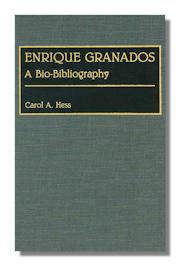
-
Enrique Granados. Carol A. Hess. Greenwood Publishing. 1991. ISBN 0313273847 (hardcover).
-
This biographical study, the first in English, draws on primary sources in English, Spanish, French, Catalan, and other languages, all of which are documented in the extensive annotated bibliography along with analytical sources and other materials. Granados's oeuvre is catalogued in a section on works and performance which also includes arrangements by other composers. A selective discography is provided, an appendix classifies the works by scoring, and a chronology relates events in the turn-of-the-century international music/artistic scene.
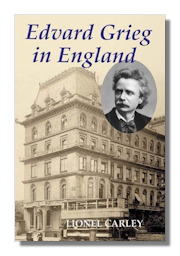
-
Edvard Grieg in England. Lionel Carley. Boydell Press. 2006. ISBN 1843832070 (hardcover).
-
When Edvard Grieg came to give his first concerts in London, he had the world at his feet. As the first composer to transmute the sights and sounds of his own spectacular country into music, he was held to be both prophet and pioneer, and English writers described him as the most popular of all living composers, commenting, when he returned to London the following year, on the "Grieg fever" that raged in the capital. Between 1862 and 1906 Grieg spent some six months of his life in this country, for most of the time engaged in giving concerts of his own music as conductor, solo pianist and accompanist. Celebrated by his fellow musicians – among them Delius, Parry, Henry Wood and Grainger – Grieg was befriended by royalty, heaped with honours that included doctoral degrees from Cambridge and Oxford, pleaded in high quarters the cause of Norwegian independence, and found new friends who effected a profound change in his religious outlook.This book explores the impact he had on England as well as examining what the country meant to him, showing how England had a far greater influence on Grieg's life and career than has hitherto been recorded. It also offers an array of fascinating insights into the musical life and milieu of the time. Lionel Carley is honorary archivist of the Delius Trust and respected author of many books about Delius.
-
Edvard Grieg – Letters to Colleagues and Friends. Finn Benestad, with William H. Halverson (Editors). Peer Gynt Press. 2000. ISBN 0964523825 (hardcover).
-
-
Charles T. Griffes: A Life in Music. Donna K. Anderson. Smithsonian. 1993. ISBN 1560981911 (hardcover).
-
In 1920, the American composer Charles Tomlinson Griffes was on the verge of a major career when he died at age 35. In the previous year, his works had been performed by the orchestras of Boston, Philadelphia, New York, and the esteemed Flonzaley Quartet. Since then, a few of his compositions – notably the 1918 Piano Sonata – have entered the repertory. Griffes is one of the most significant composers America has yet produced. In this first book about Griffes in half a century, the author's affectionate treatment wears its scholarship lightly. Although reflecting extensive research, Anderson's prose is unpretentious and easy to read. Her overview of Griffes's musical style traces his development from German models to French Impressionism, and ultimately to forging his own musical language. The accompanying discography is especially useful. Recommended for serious music collections.
-
Charles T. Griffes: The Life of an American Composer. Edward Maisel. Alfred A. Knopf. 1984. ISBN 0394540816 (paperback).
-



























